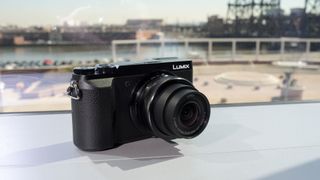Panasonic's new GX80 packs big 4K features into a petite mirrorless body
The Panasonic GX8 is powerful but big; the GF7 is small but has no viewfinder – so the GX80 plugs the gap beautifully

Panasonic makes mirrorless cameras in two styles, its DSLR lookalikes the GH4 and G7 and its rectangular, rangefinder-style GX and GF cameras – and the GX80 falls into the rangefinder camp.
This is where Panasonic seems to be putting most of its effort right now, not least because the recently-launched GX8 was the first to get the company's brand new 20-megapixel Micro Four Thirds sensor.
The GX8 is currently the flagship of the Panasonic range, but it's a pretty big camera, with a pretty big price tag to match, so the announcement of the GX80 (GX85) in the US is actually rather exciting, because it promises much of the power of the top-end camera but in a smaller, more affordable body – and without sacrificing the electronic viewfinder that is such a useful feature on mirrorless cameras.
- Read our Panasonic GX80/GX85 hands on review

Interestingly, Panasonic has stuck with its 'old' 16-megapixel sensor for the GX80, though it has removed the anti-aliasing filter for the first time in its mirrorless camera range to deliver a boost in fine detail rendition of 10%.
Any potential moiré (interference) patterns that might result are dealt with by a new Venus image processing system, which also allows a maximum ISO of 25,600.
Panasonic might have held back from using its latest sensor, but it's crammed in all its latest tech elsewhere. The GX80 has Panasonic's latest 5-Axis Dual I.S. image stabilisation system. This combines 2 axes of movement from a lens stabiliser with 5 axes of in-body stabilisation.
It also has a brand new shutter design which minimises vibrations and sound when pressing the shutter button and Panasonic's innovative DFD (Depth From Defocus) autofocus system which uses images with different focus settings to determine the distance and direction for autofocus adjustment.
Get daily insight, inspiration and deals in your inbox
Get the hottest deals available in your inbox plus news, reviews, opinion, analysis and more from the TechRadar team.

As you'd expect from any new Panasonic now, the GX80/GX85 can shoot 4K video but also uses its 4K capabilities for 4K photo modes, where you can shoot continuously at 30 frames per second and extract an 8-megapixel still from any frame. This is half the sensor's native resolution, but still enough for good-quality A3-size prints, according to Panasonic.
The 4K photo mode also offers Panasonic's new Post Focus function, which allows you to select a focus point after you've taken a picture, just by tapping on a screen, and it adds a new Light Composition function where the camera combines several frames into one final image, using the brightest pixels for each. This should be ideal for low-light, high-contrast subjects such as fireworks displays.

Panasonic's also keen to push the camera's ability to produce moving pan and zoom effects in full HD from stationary 4K video, all achieved in-camera with customisable start and end points.
The GX80/GX85 will go on sale from May 9th 2016 in black and silver (the silver finish is exclusive to Jessops in the UK) and tan (exclusive to UK dealer John Lewis.
The price with Panasonic's compact 12-32mm kit lens will be £599/US$799.99. It will also go on sale in the UK in body-only form at £509 and as a twin-lens kit including 12-32mm and 35-100mm lenses for £729.
Most Popular

